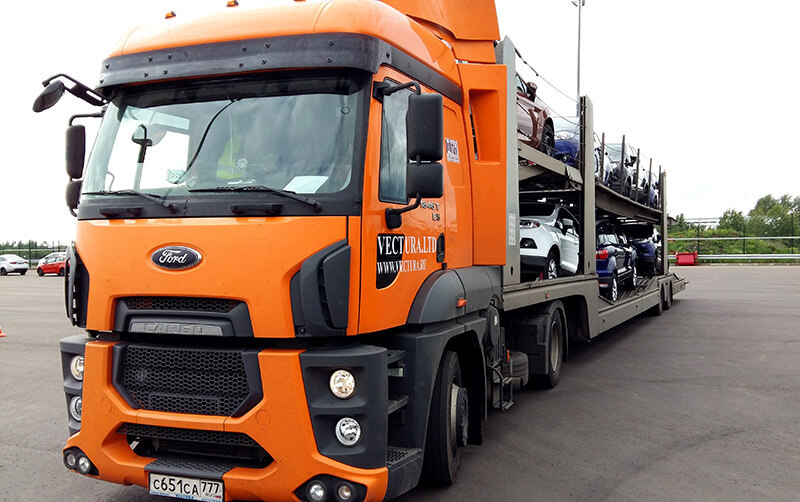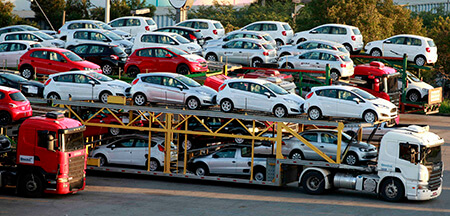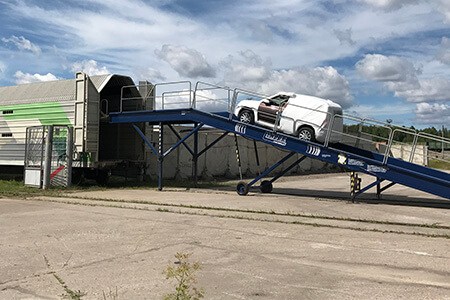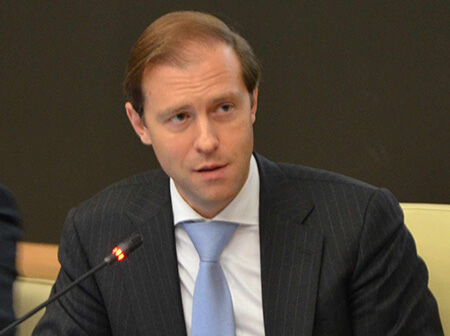 Sales of finished vehicles in Russia rose 11.9% in 2017 over the previous year to reach 1.59m units, according to estimates in early January by the Association of European Businesses (AEB). Russia’s long-awaited recovery began in March and gained momentum throughout the year, peaking in December with monthly sales of 166,000 finished vehicles – up 14% on the same month the previous year.
Sales of finished vehicles in Russia rose 11.9% in 2017 over the previous year to reach 1.59m units, according to estimates in early January by the Association of European Businesses (AEB). Russia’s long-awaited recovery began in March and gained momentum throughout the year, peaking in December with monthly sales of 166,000 finished vehicles – up 14% on the same month the previous year.
The turnaround has certainly been welcomed, given the shrinking sales volumes seen since 2012. While OEMs and logistics providers hope this signals a major recovery in the market, 2018 looks like it could be a year of further uncertainty for the automotive industry in Russia.
For the first time ever, the AEB has not released its usual sales forecast for the coming 12 months, suggesting that there are simply “too many variables” involved.
At a press conference in early January, Jorg Shreiberg, AEB chairman and director of MazdaMotor Rus, said there was no clarity about levels of taxation in the industry, including proposed increases to the utilisation fee and excise rates.
The Russian authorities are planning to nearly double excise rates on finished vehicles this year, according to reports in local media late last year which cited government insiders. And the government has already increased the utilisation fee by 90% for cars with 1.0-2.0 litre engines and 49% for those with 2.0-3.0 litre engines.
 At the same time, the Russian authorities have significantly cut funding under programmes to support domestic vehicle demand. Denis Manturov, minister of industry and trade in Russia, revealed at a recent press conference that the government planned to issue 35 billion roubles ($600m) of funding under these programmes in 2018 – around half the level of the previous year. It is believed that this new rate will only be maintained for the next two years before a further reduction.
At the same time, the Russian authorities have significantly cut funding under programmes to support domestic vehicle demand. Denis Manturov, minister of industry and trade in Russia, revealed at a recent press conference that the government planned to issue 35 billion roubles ($600m) of funding under these programmes in 2018 – around half the level of the previous year. It is believed that this new rate will only be maintained for the next two years before a further reduction.
[related_topics align="right" border="yes"]The sharp hike in utilisation fee and the cut in state aid will both undermine the expected recovery in the finished vehicle market this year, according to the Russian Association of Automotive Dealers (RAAD). It suggests that growth in vehicle sales could fall to just 6.5% this year, leaving total annual vehicle sales at around 1.7m units. Most industry observers appear to agree.
Oil boostNot everyone in the market is worried about the recent changes in government policy, however. Tatiana Hristova, Russian market analyst for IHS Markit, says that she still expects a higher pace of growth this year, given the boost to Russia’s economy from steadily rising oil prices of late.
“IHS Markit expects slightly higher growth rates for 2018, compared to last year,” she confirms. “However, we expect a stronger increase in vehicle sales in the first half of the year than the second half, due to the end of pre-election government initiatives and the traditional slowdown in the economy after major events in the country, such as the FIFA World Cup 2018.
 "We expect a stronger increase in vehicle sales in the first half of [this] year than the second half, due to the end of pre-election government initiatives and the traditional slowdown in the economy after major events in the country." - Tatiana Hristova, IHS Markit
"We expect a stronger increase in vehicle sales in the first half of [this] year than the second half, due to the end of pre-election government initiatives and the traditional slowdown in the economy after major events in the country." - Tatiana Hristova, IHS Markit
“The current oil price level of around $70 per barrel is much higher than has been included in most business plans and budgets at Russian companies, and even the government, for this year,” she continues. “The recent agreements in OPEC and non-OPEC countries about continuing to restrict production will maintain oil prices at a level slightly below $70/barrel in coming months.”
At the same time, IHS Markit is forecasting a strong upward trend in the luxury segment of the market.
“The second-biggest premium segment, D-premium segment, just started to recover and will show solid growth rates this year,” suggests Hristova. “This segment will also profit from some relief after some very lengthy corporate budget cuts. Sales of the traditional segment leaders, the Mercedes C-Class and BMW 3-Series, will be supported by high demand for SUVs. And we expect the same for the C-premium segment, where sales of the Mercedes GLA, BMW X1 and Audi Q3 will be boosted by sales of the new Volvo XC40 and Range Rover Evoque.”
Azat Timerkhanov, a spokesperson for Russian consultancy AutoStat, agrees that finished vehicles sales in the country will be affected by global oil prices. At an oil price of $75 per barrel, Timerkhanov suggests, vehicle sales could rise 20% to reach 1.75m units a year; at $65 per barrel, however, the market would grow only 10%; at $55 per barrel, meanwhile, it would not grow at all.
Optimism about the Russian market may be overplayed, warns AutoStat, as the Russian population’s purchasing power is still weak, while the increase in utilisation fee will force carmakers to raise vehicle prices by 5-7%, compared with the end of last year.

Capacity crunchEven if vehicle sales in Russia do continue to recover, it will put further pressure on a logistics sector already suffering from serious road transport capacity shortages after cutbacks following several years of falling volumes.
In July last year, Russian automotive logistics providers began to raise concerns about road transport capacity, as finished vehicle numbers picked up after the summer. A capacity squeeze started to become apparent in late September and has continued ever since.
“A reduction in the national fleet of car transporters in the country has led to a lack of capacity in the market,” confirms Dmitry Vostrikov, director of WWL Russia. “In autumn 2017, the market was already experiencing difficulties in finding sufficient capacity, which has resulted in rising haulage rates. The trend is likely to continue.
“Suppliers and trucking companies are not willing to invest in new vehicles without long-term commitments from their customers. But customers, in turn, are unwilling to assume any risks or liabilities, given the unpredictable situation with sales in 2018,” Vostrikov explains. “And one of the factors that could negatively affect sales is the change in the utilisation fee.”
“In July, key logistics providers in the Russian finished vehicle market expected a capacity shortage in road transport to start taking effect between October and December; in actual fact, it started to happen earlier, at the end of August,” says Kirill Glukhov, business development director at logistics provider Vectura.
“As soon as it became clear that the situation was getting worse and that it was the beginning of a long-term trend, carmakers started fighting for transport capacity. It is now clear to everyone that the industry urgently needs to invest in additional new or used automotive carriers, to replace the ones taken off the road in the crisis,” he adds.
 Glukhov says car carriers in reasonable condition could still be found in the autumn, but that since December there has been no spare capacity in the market at all after demand “jumped dramatically”.
Glukhov says car carriers in reasonable condition could still be found in the autumn, but that since December there has been no spare capacity in the market at all after demand “jumped dramatically”.
Vladimir Abramov, finished vehicle logistics fleet manager at Gefco Russia, says this transport shortage has even been evident in relatively calm periods.
“According to various reports, there are 3,800 to 4,200 automotive carriers permanently operating on the Russian market,” he says. “During 2017, all previously parked-up carriers were brought back into operation, so the fleet of automotive carriers in Russia can now only grow through acquisition of new units by transport companies.
“Significant growth in the fleet is not expected during 2018, however, because most transport companies will first need to replace their ageing current car transporters. At most, growth this year could amount to just 100-200 transporters – and even that will only happen if finished vehicle volumes in the market stay at the level they were at in autumn last year,” continues Abramov.
[mpu_ad]Sergey Bobryshev, logistics director at Glovis Rus, estimates the overall shortage of transport capacity at 20-25% of total demand.
Rising ratesThis capacity crisis in the Russian market has sent road transport prices soaring and forced logistics providers to look more closely at other modes of transport.
“Starting from November or December last year, there was an increase in rates under long-term contracts on the market, on average 30-50%, depending on routes and volumes,” Glukhov suggests.
Some transport providers have raised their rates to help fund fleet modernisation, he says, and some OEMs have started talking with transport providers about participating in various investment schemes, in a bid to secure transport capacity for their shipments.
Despite such hikes, says Abramov, rates remain relatively low and will need to rise still further, if transport companies are to invest adequately in fleet renewal.
“On average, tariffs in the industry have increased by about 30% since September. However, this is only a rough estimate as each client has its own demands and transport companies, therefore, have to discuss rates with each customer individually,” Bobryshev comments.
Alena Sheligovska, former leading specialist of goods flow, planning and logistics at Ford Sollers, agrees that despite recent growth, haulage rates in the Russian market remain extremely low. It is not really clear how transport companies are managing to survive as rates in Russia remain much lower than those in the wider European market, says Sheligovska.
 In parallel to a lack of road transport there is a surplus of rail capacity, which has led to a more flexible pricing policy on the part of Russian Railways
In parallel to a lack of road transport there is a surplus of rail capacity, which has led to a more flexible pricing policy on the part of Russian RailwaysWhat increases there have been have also varied from region to region. For example, on the route between Moscow and St. Petersburg, there is so much competition that prices have remained mostly flat, she says. Other regions such as the Urals, where there are far fewer transport companies, have seen strong growth in rates in recent months.
Against this background, some logistics providers have returned to using rail. The number of finished vehicles transported in Russia by rail has been falling since 2014, but that could conceivably change this year, some suggest.
Gefco, for example, points out that there is substantial surplus in rail car capacity in the country, with nearly 1,000 rail car transporters reportedly standing idle last year, leading Russian Railways to adopt a more flexible pricing policy.
Abramov says rail has its uses over medium and long distances, for both inbound and outbound movements – but suggests that logistics providers really need to match customer expectations in terms of time and quality.
Inbound and outbound logistics operations are also shifting somewhat towards sea freight, with a growing number of movements being routed via the ports of St. Petersburg and Novorossiysk, says Abramov.
Bobryshev, however, maintains that Russia’s railway infrastructure is still relatively weak and points out that in terms of speed, finished vehicle delivery via rail is not competitive with road. He believes, therefore, that the potential for growth in rail is limited.
Between all these issues and fast-growing concerns over the impact of looming changes to Russia’s industrial assembly agreements (see box, below), it remains too early, it seems, for the finished vehicle sector in the country to start celebrating just yet – despite the very welcome recent recovery in demand for new cars.
"On average, tariffs in the industry have increased by about 30% since September. However, this is only a rough estimate as each client has its own demands and transport companies, therefore, have to discuss rates with each customer individually." - Sergey Bobryshrev, Glovis Rus
 Denis Manturov, Russian minister of industry and trade, has admitted some car plants could close down due to SPICs
Denis Manturov, Russian minister of industry and trade, has admitted some car plants could close down due to SPICsA further factor affecting the future of the automotive sector in Russia is the question of what policy the government will now apply to vehicle assembly and localisation in the country.
Recent statements by government officials suggest that Russia’s industrial assembly contracts are likely to be replaced with so-called special investment contracts (SPICs) from next year.
A move to SPICs could result in several assembly plants in Russia shutting down in the next few years, as Denis Manturov, minister of industry and trade in Russia, conceded at a press conference recently.
Manturov’s comments sent a tremor through the automotive sector, given the ministry’s previous efforts to encourage carmakers to remain in Russia at all costs. There is now real fear that the government will abandon the incentives provided to carmakers over the past decade under industrial assembly agreements.
The government is hoping the move to the SPIC scheme will encourage more localised production of components that are currently supplied from abroad, says Marina Piotrovskaya, a spokesperson for law firm DLA Piper.
 “The SPIC regime would be an [acceptable] alternative to the industrial assembly agreement only if it provided its holders with compensation for the losses they will suffer from the expected alignment of tariffs [from 0% on components under existing industrial agreements to 25% afterwards], along with a reduced requirement in terms of investment for companies that have established production facilities in Russia over the past ten to 12 years,” she comments.
“The SPIC regime would be an [acceptable] alternative to the industrial assembly agreement only if it provided its holders with compensation for the losses they will suffer from the expected alignment of tariffs [from 0% on components under existing industrial agreements to 25% afterwards], along with a reduced requirement in terms of investment for companies that have established production facilities in Russia over the past ten to 12 years,” she comments.
It’s conceivable, admits DLA Piper, that the government might decide to support only those manufacturers in future who commit to relocating high-tech production facilities, advanced technologies or the production of various automotive components that have not previously been manufactured in the country.
Until the ministry reveals how many factories it expects to close down as the current industrial assembly agreement regime ends, it is difficult to predict just what the effects on Russia’s automotive sector will actually be.
Topics
- AEB
- Association of European Businesses
- AutoStat
- DLA Piper
- Europe
- features
- Finished Vehicle Logistics
- Ford-Sollers
- Gefco Russia
- Glovis Rus
- Hyundai Glovis
- IHS Markit
- Inbound Logistics
- MazdaMotor Rus
- Policy and regulation
- RAAD
- Rail
- Road
- Russian Association of Automotive Dealers
- Russian Federation
- Russian Railways
- Shipping
- Suppliers
- Supply Chain Planning
- Vectura
- WWL Russia




































